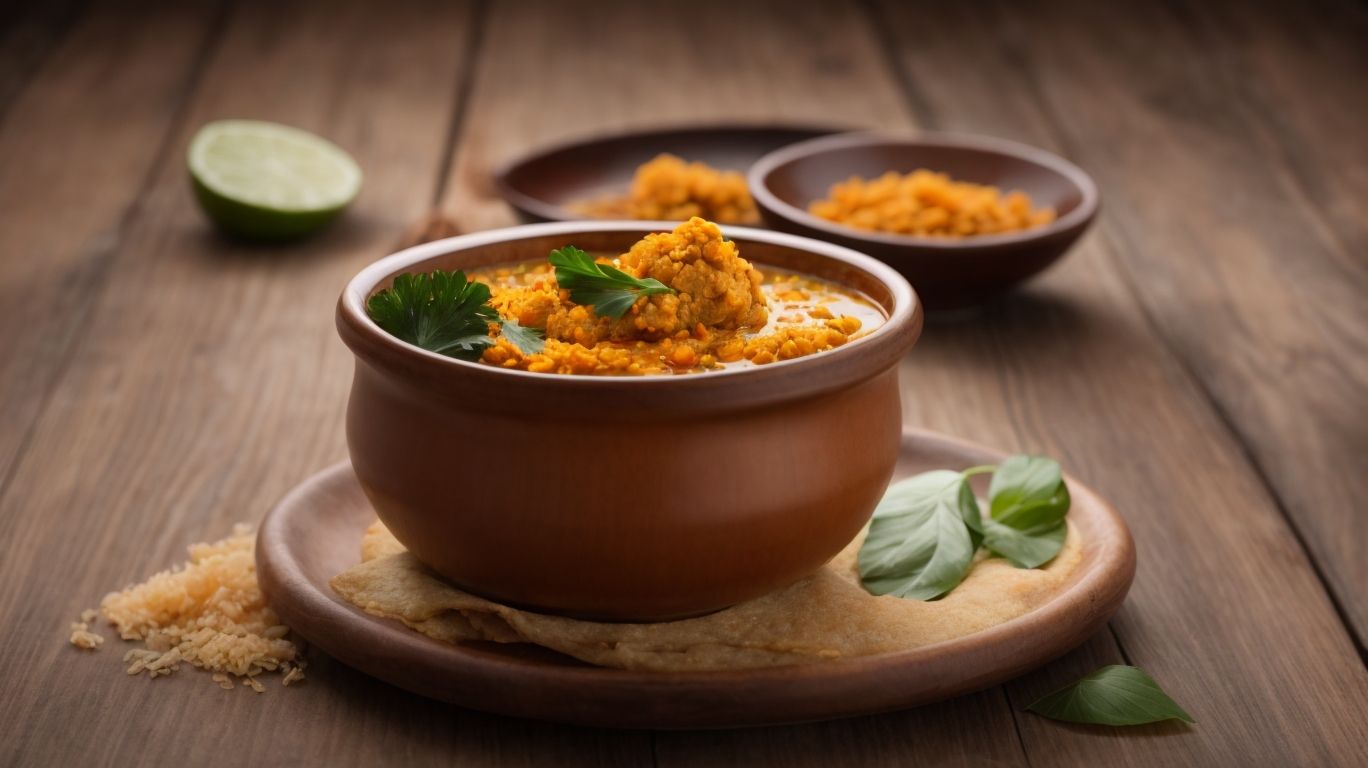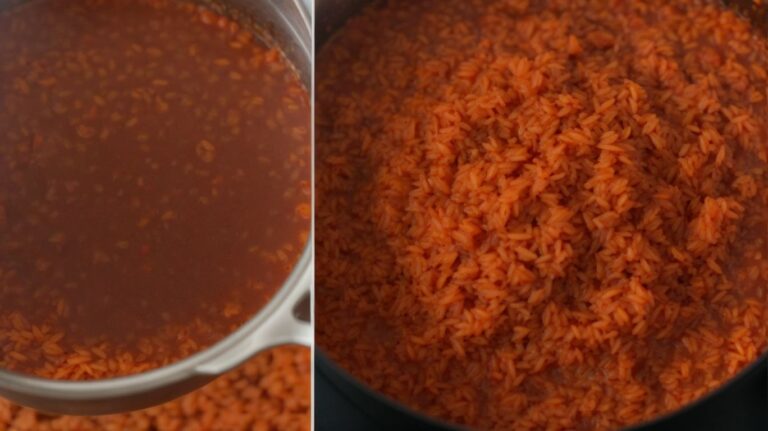How to Cook Egusi Soup With Bitter Leaf?
Are you looking to elevate your cooking skills with a delicious and nutritious Nigerian dish?
Try Egusi Soup with Bitter Leaf! We guide you through the process of preparing this flavorful and hearty soup, from gathering the necessary ingredients and tools to incorporating the unique flavor of bitter leaf.
Whether you’re a seasoned chef or a beginner in the kitchen, this recipe will surely impress your taste buds and leave you craving for more. Let’s get cooking!
Key Takeaways:
About Egusi Soup and Bitter Leaf
Egusi Soup and Bitter Leaf are quintessential dishes in Nigerian cuisine, celebrated for their rich flavors and cultural significance in Nigerian food culture.
Egusi Soup, made from ground melon seeds, is not just a dish in Nigeria but a cultural symbol that reflects the tradition and essence of communal dining in Nigerian households. This hearty soup often includes ingredients like meat, fish, vegetables, and traditional spices, creating a flavorful and satisfying meal. The preparation of Egusi Soup involves meticulous blending of ingredients and simmering to perfection, enhancing the nutty flavor of the egusi seeds.
Bitter Leaf, on the other hand, is revered for its unique taste and medicinal properties in Nigeria. This bitter vegetable is often used in soups and stews to balance flavors and provide a distinct earthy undertone. Bitter Leaf is believed to have cleansing properties and is traditionally prepared by washing the leaves thoroughly to reduce bitterness before cooking.
What You’ll Need for Egusi Soup With Bitter Leaf?

Credits: Poormet.Com – Christopher Hernandez
To prepare a delicious Egusi Soup with Bitter Leaf, gather essential ingredients such as assorted meats, stock fish, melon seeds, and palm oil to capture the authentic flavors of Nigerian cuisine.
Don’t forget to include aromatic spices like ground crayfish, locust beans, and dried pepper for that extra kick of flavor. The combination of these key elements creates a rich and hearty broth that forms the base of the soup.
For the vegetable component, traditional Egusi Soup with Bitter Leaf calls for fresh bitter leaf leaves, providing a unique bitterness that balances the richness of the other ingredients.
The cooking process involves slow simmering to allow the flavors to meld together and intensify, resulting in a wholesome and satisfying dish that can be enjoyed with a side of fufu or rice.”
Ingredients
The ingredients for Egusi Soup with Bitter Leaf encompass a flavorful ensemble of assorted meats, stock fish, melon seeds, palm oil, and a medley of vegetables that define the essence of traditional Nigerian cuisine.
Assorted meats like goat, beef, or chicken provide a rich and savory base to the soup, infusing it with depth of flavor.
Stock fish, with its unique taste and texture, adds a distinctive umami element to the dish,
while melon seeds, also known as Egusi seeds, give a thickening and nutty richness to the soup.
The palm oil not only imparts a vibrant color but also contributes a velvety mouthfeel when combined with the other ingredients.
The medley of vegetables, including bitter leaf, adds a refreshing bitterness that balances the richness of the soup, creating a harmonious blend of flavors.
Tools
For the preparation of Egusi Soup with Bitter Leaf, basic kitchen tools such as pots, knives, cutting boards, and wooden ladles are essential for a successful culinary endeavor that embodies the essence of homemade Nigerian delicacies.
Plus the essential kitchen tools, other utensils like a wooden spoon for stirring, a blender or mortar and pestle for grinding the egusi seeds, and a colander for washing the bitter leaf are also crucial in the preparation process.
Having a variety of spices such as ground crayfish, locust beans, and seasoning cubes will enhance the flavors of the soup, offering a true taste of traditional Nigerian cuisine.
To ensure a smooth cooking experience, make sure to have a deep pot for simmering the soup and a traditional clay pot for serving, adding an authentic touch to the final presentation.
How to Prepare the Bitter Leaf for Cooking?
Preparing Bitter Leaf for cooking involves a meticulous process of washing, boiling, and draining to remove bitterness, ensuring a delightful addition to traditional Nigerian soups.
First, start by picking fresh Bitter Leaf from the stems and twigs, ensuring to select only the leaves.
Next, rinse the leaves thoroughly in a bowl of water, gently rubbing them to remove any dirt or impurities. You can repeat this step a few times until the water runs clear.
Then, fill a pot with water and bring it to a boil. Add the washed Bitter Leaf into the boiling water and let it simmer for about 5-10 minutes to reduce the bitterness.
How to Prepare the Egusi Soup?
The preparation of Egusi Soup is a cherished tradition in Nigerian culture, where the blend of melon seeds, palm oil, and assorted meats creates a luscious and aromatic dish that symbolizes the richness of Nigerian culinary heritage.
Egusi Soup holds a significant place in Nigerian households and gatherings, often being prepared for special occasions and celebrations. To start making this traditional dish, the first step is to grind the melon seeds into a fine paste.
Next, heat up some palm oil in a pot and add chopped onions, tomatoes, and assorted meats such as beef, goat meat, or fish to create a rich base for the soup.
Once the flavors have melded together, the ground melon seed paste is added to the pot, along with stock or water to achieve the desired consistency.
Step 1: Blend the Egusi Seeds
To start preparing Egusi Soup, the initial step involves blending melon seeds to create a smooth paste that forms the flavorful base of this iconic Nigerian dish.
Creating this paste is crucial as it not only unlocks the rich, nutty flavor of the Egusi seeds but also contributes to the thick texture that gives the soup its characteristic consistency. The process of blending the seeds requires patience and precision to achieve the right balance of smoothness and thickness.
Traditionally, a mortar and pestle are used to grind the seeds, ensuring that the paste retains its authenticity and robust flavor. The aroma that fills the kitchen during this step is a testament to the essence of Nigerian cuisine and the care put into each dish.
Step 2: Heat the Oil and Fry the Egusi
Next, heat palm oil and fry the blended Egusi paste to release its nutty flavors and aromas, infusing the soup with a rich and indulgent taste that characterizes this beloved Nigerian delicacy.
When heating the palm oil for Egusi Soup, it’s crucial to ensure the oil reaches the right temperature before adding the Egusi paste. This step helps to intensify the natural flavors of the palm oil, creating a robust base for the soup.
As the Egusi paste fries, its unique aroma fills the kitchen, signaling the development of a deep, savory profile. The sizzling sound as the paste hits the hot oil signifies the beginning of a culinary transformation.
Timing is key here; a perfect balance between cooking the Egusi paste until it darkens slightly without burning is essential. This process unlocks the Egusi’s full potential, bringing out its nutty undertones and enhancing its creamy texture.
Step 3: Add the Meat and Stock
Subsequently, add assorted meats and stock fish to the Egusi mixture, allowing the flavors to meld and create a savory depth that reflects the heartiness of Nigerian cuisine.
When incorporating the assorted meats, such as beef, goat, or chicken, into the simmering Egusi soup, it’s essential to consider the varying cooking times each meat requires. Beef may need a longer simmer to tenderize, while chicken cooks relatively quickly. This varied cooking process infuses the soup with layers of flavors that complement the rich ground egusi seeds.
Stock fish, a staple in Nigerian cuisine, adds a unique umami depth and texture to the soup. It is crucial to soak the stock fish beforehand to soften its texture and allow it to absorb the flavors of the soup during the cooking process.
Step 4: Add the Vegetables
Add a vibrant selection of vegetables to the Egusi Soup, introducing color, texture, and nutritional value to this iconic Nigerian dish that exemplifies the essence of traditional home cooking.
Commonly used vegetables in Egusi Soup include spinach, okra, and bell peppers. These veggies are not only visually appealing but also contribute significantly to the overall taste and health benefits of the dish. To prepare them, wash and chop the spinach into manageable pieces, slice the okra into rounds, and dice the bell peppers for added crunch and flavor. These vegetables not only enhance the presentation by adding vibrant hues but also increase the nutrient profile of the soup, making it a wholesome meal choice for all.
How to Incorporate the Bitter Leaf into the Soup?
Incorporating Bitter Leaf into the soup involves a careful process of washing, boiling, and combining it with the flavorful broth, adding a distinct bitter undertone that complements the richness of Nigerian cuisine.
Before using Bitter Leaf in your soup, it’s essential to wash it thoroughly to remove any dirt or bitterness. Start by placing the leaves in a bowl of water and gently massaging them to release any impurities. Repeat this process a few times until the water runs clear.
Once cleaned, you can add the Bitter Leaf to a pot of boiling water and blanch it for a few minutes. This helps soften the leaves and reduce their bitterness. Drain the blanched leaves and squeeze out excess water.
To balance the bitterness of Bitter Leaf, consider adding ingredients like crayfish, stockfish, or smoked fish to your soup. Their robust flavors can complement the bitterness, creating a harmonious blend of tastes.
Step 1: Wash and Boil the Bitter Leaf
Begin by washing and boiling the Bitter Leaf to remove bitterness and soften its texture, preparing it for integration into the savory Egusi Soup that embodies the essence of traditional Nigerian cuisine.
Washing and boiling the Bitter Leaf is a crucial step in Nigerian cooking, especially for dishes like Egusi Soup. This process not only helps to rid the leaf of its bitter taste but also ensures that it reaches the perfect level of tenderness when added to the rich soup.
The bitter leaf, known for its distinctive taste, requires this meticulous treatment to harmonize with the flavors of the soup. Boiling the leaf softens it just enough to blend seamlessly with the other ingredients, contributing to the overall depth and complexity of the dish.
By giving attention to even the smallest details like washing and boiling, Nigerian cooks honor the culinary traditions that have been passed down through generations, resulting in a truly authentic dining experience.
Step 2: Add the Bitter Leaf to the Soup
Add the prepared Bitter Leaf to the Egusi Soup, allowing its unique flavor profile to infuse the dish with a delightful bitterness that underscores the complexity and depth of this traditional Nigerian delicacy.
Before incorporating the Bitter Leaf, make sure it is washed thoroughly to reduce its bitterness slightly. Once ready, gently fold the Bitter Leaf into the simmering Egusi Soup, letting it mingle with the rich blend of spices and meats. The cooking duration is crucial here; you want to cook the soup slowly to allow all the flavors to harmonize. The Bitter Leaf needs time to soften and release its distinct taste, blending seamlessly with the nutty undertones of the Egusi.
Patience is key as the soup simmers, adjusting seasoning if needed to balance out the bitterness of the leaves.
How to Serve and Enjoy Egusi Soup With Bitter Leaf?
To savor Egusi Soup with Bitter Leaf, serve it hot alongside a side of pounded yam, rice, or any preferred staple, relishing the harmonious blend of flavors that encapsulate the essence of Nigerian cuisine.
As you prepare to dig into this delicious dish, remember that in Nigerian culture, sharing a meal is often seen as a communal experience. When presenting Egusi Soup with Bitter Leaf, consider using traditional ceramic or wooden bowls, adding an authentic touch to your dining setting.
For an added burst of freshness and crunch, consider garnishing the soup with thinly sliced okra or diced tomatoes. These vibrant additions not only enhance the visual appeal of the dish but also introduce contrasting textures that elevate each bite.
Incorporating a side of freshly baked plantain or cassava fufu can complement the rich, nutty flavors of the Egusi soup, creating a well-rounded and satisfying meal that celebrates the diversity of Nigerian cuisine.
Frequently Asked Questions
What is Egusi Soup with Bitter Leaf?
Egusi soup is a popular Nigerian soup made with ground melon seeds and bitter leaf. Bitter leaf is a type of leafy green vegetable that adds a unique flavor to the soup.
Why is Bitter Leaf important in Egusi Soup?
Bitter leaf is an essential ingredient in Egusi soup as it adds a distinct bitterness to balance out the richness of the other ingredients. It also has medicinal properties and is known for its detoxifying effects.
What are the ingredients needed to make Egusi Soup with Bitter Leaf?
The main ingredients for Egusi soup with Bitter Leaf are ground Egusi seeds, bitter leaf, palm oil, various meats (such as beef, chicken, or fish), and seasoning. Other optional ingredients include onions, crayfish, and chili peppers for added flavor and spice.
How do I prepare Bitter Leaf for Egusi Soup?
Bitter leaf needs to be properly washed and soaked in saltwater for at least 30 minutes to remove its bitter taste. After soaking, rinse the leaves with clean water and chop them into small pieces before adding them to the soup.
What is the best way to cook Egusi Soup with Bitter Leaf?
There are different ways to cook Egusi Soup with Bitter Leaf, but the most common method is to first sauté onions and chili peppers in palm oil, then add the ground Egusi and cook until it forms a thick paste. Next, add in the meats, seasoning, and water, and let it simmer for about 30 minutes before adding in the bitter leaf. Cook for an additional 10 minutes and serve with your choice of side dish, such as pounded yam or rice.
Can I substitute Bitter Leaf with any other ingredient?
While bitter leaf is an essential ingredient in traditional Egusi Soup, you can substitute it with other leafy greens such as spinach or kale if you are unable to find bitter leaf. However, keep in mind that this will alter the flavor of the soup.



